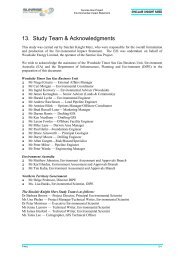Appendix D Terrestrial and Aquatic Biodiversity - Environment ...
Appendix D Terrestrial and Aquatic Biodiversity - Environment ...
Appendix D Terrestrial and Aquatic Biodiversity - Environment ...
Create successful ePaper yourself
Turn your PDF publications into a flip-book with our unique Google optimized e-Paper software.
5.5.2 Rocky S<strong>and</strong>stone Ridges<br />
Rocky s<strong>and</strong>stone ridges are geological ‘isl<strong>and</strong>s’ within the savanna. Because they are often protected from<br />
frequent fire events, s<strong>and</strong>stone ridges provide potential refuge for threatened or restricted range species:<br />
such as Rock Rats, S<strong>and</strong>stone Antechinus (Pseudantechinus bilarni), Borroloola Dtella (Gehyra borroloola)<br />
<strong>and</strong> Agile Snake-eyed Skink (Cryptoblepharus zoticus) that are susceptible to disturbance. Cave-forming<br />
rock also provides additional habitat for bats. There is also the possibility that Solanum carduiforme (a rare<br />
form of bush tomato which is vulnerable under the EPBC Act) could also occur in these s<strong>and</strong>stone ridges, as<br />
it has been identified in the Limmen Gate area 40km to the south of the haul road.<br />
Three s<strong>and</strong>stone outcrops were identified close to the proposed haul road alignment (labeled as R7, R115,<br />
<strong>and</strong> R116 in Figure 34 to Figure 37) have been identified within haul road corridor. It was recommended that<br />
these areas are avoided with a minimum 50m buffer during construction of the haul road, which was adopted<br />
by WDRL. It was also recommended that direct impacts are minimised at a number of both high <strong>and</strong> low<br />
value s<strong>and</strong>stone areas (R1, R9, R17, R21 <strong>and</strong> R30). The survey also identified that there are large areas of<br />
high value rocky outcrop <strong>and</strong> ridge habitat in the northern reaches of the haul road corridor, all outside of the<br />
proposed clearing path.<br />
Locations, descriptions, habitat value <strong>and</strong> recommendations for each s<strong>and</strong>stone outcrop surveyed are shown<br />
in <strong>Appendix</strong> D-10.<br />
5.5.3 The Yiyintyi Ranges<br />
The Yiyintyi ranges are an isolated entity of the Arnheml<strong>and</strong> upl<strong>and</strong> plateau. The ranges consist of pink,<br />
flaggy, medium grained quartz s<strong>and</strong>stone <strong>and</strong> feature dissected plateaus <strong>and</strong> fault springs (Nott 2005).<br />
The greater proportion of the Yiyintyi ranges is located as an extensive <strong>and</strong> broad range to the north of the<br />
haul road corridor. To the south the Yiyinti formation is present as less extensive but somewhat ribbon-like<br />
or parallel, linear ridges. The haul road corridor passes through foothills in the near proximity of Rosie River,<br />
at point where scattered patches of the Yiyintyi formation loosely connect these two major extents. Results<br />
from the fauna survey located within this l<strong>and</strong> type suggest that these ranges are particularly diverse from a<br />
regional perspective.<br />
Although the level of sampling is quite limited (for the extent of the Yiyintyi ranges) the Rosie River survey<br />
site featured the greater diversity of birds <strong>and</strong> mammals compared to any of the other haul road survey<br />
locations. The fauna survey site (R3) actually on the ranges was the most diverse compared to other<br />
associated habitats in the near vicinity (e.g. drainage <strong>and</strong> woodl<strong>and</strong> areas).<br />
Five of recorded mammal species from the Rosie River survey location were not recorded for any of the<br />
other survey locations along the haul Road route. There was also an unconfirmed, but highly likely, sighting<br />
of Ghost Bats (Macroderma gigas) at the Rosie River s<strong>and</strong>stone survey site (R3), see below.<br />
Of particular note for the Rosie River survey site within the Yiyintyi s<strong>and</strong>stone, was a significant range<br />
extension (400km) for the frog species Limnodynastes lignarius (confirmed by the NT museum by<br />
photographs <strong>and</strong> recording of the call) which is also a new species record for the Gulf Fall Upl<strong>and</strong> Bioregion.<br />
This species is more typically found in north western parts of Northern Territory with the nearest records<br />
being in locations such as Kakadu.<br />
Based on the limited level of data available the Yiyintyi rangel<strong>and</strong> system is obviously significant at a<br />
bioregional scale. With a greater level of survey effort, <strong>and</strong> particularly a focus on collecting genetic<br />
information, the significance of these ranges may be greater than currently suggested.<br />
Client: Western Desert Resources Ltd Page 112 of 150<br />
Doc No. DW120004-C0302-EIA-R-0036<br />
Doc Title: <strong>Appendix</strong> D – <strong>Terrestrial</strong> <strong>Biodiversity</strong> Technical Report



